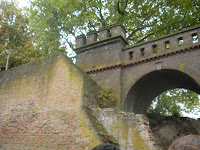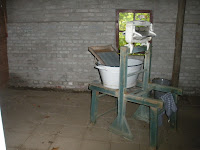Arnhem
Openluchtmuseum
 |
| Map of the Grounds |
The Openluchtmuseum, or Open Air Museum is a museum that gives a picture of life in the Netherlands during the last
centuries. It was opened in July 1918, and was a national museum until 1993. Almost all the buildings and features are original, and were slowly brought to the grounds one by one. The Museum covers approximately 108 acres, and all of it is very accessible thanks to the ring-shaped tramway they constructed (1996). You can also visit their official website to read more about them and the grounds here:
http://www.openluchtmuseum.nl/en/ .
Despite the fact that it rained the whole day, we were having a really good time. The museum was beautiful and definitely not what I expected. I thought it would be just a museum with a few buildings that housed artifacts and items linked to the Dutch culture's past. Which a few buildings were, but they only had enough space to hold so much. I was fascinated by how much it reminded me of the time I went to Old World Wisconsin, the only differences being that here they had windmills and it wasn't separated into different diversities (it's all Dutch, duh!). **On a side note, I also recommend seeing Old World Wisconsin
http://oldworldwisconsin.wisconsinhistory.org/, it's always nice to hear about our own past.** They have several people working on the grounds to give you the experience of being "back in the good ol' days." I think my favorite part about that was at one of the farming houses was a family that was making homemade black tea for you over a campfire, and it was amazing!!! I loved it and really wish I could've had seconds!
Now here are a "few" photos from the museum:

And here are some photos people have uploaded...
 |
| The tram |
 |
| WOODEN SHOES |
Nijmegen
City Tour
Nijmegen is the oldest city in the Netherlands. The first mention of
Nijmegen in history is in the 1st century BC, when the Romans built a military camp on the place where Nijmegen was to
appear; the location had great strategic value because of the surrounding
hills, which gave (and continues to give) a good view over the Waal and Rhine valley. Few Roman remains are
visible today; Valkhof hill downtown features a Carolingian chapel
(eight, ninth century AD) and a small remainder of an imperial castle that was
demolished in 1798 (to help pay for the cities' debt..). From Valkhof
hill, you can walk down Burchtstraat. Here you will see, on your left hand side,
the fifteenth-century town hall. If you've finished admiring its exterior, you
can continue to the Grote Markt (Great Market) on the north side of which is a
sixteenth-century weighing hall that now serves as a restaurant. On the west
side, you will see the entrance to the St. Stevenskerk courtyard. On the left
is a fifteenth-century Latin school. On the right stands the thirteenth-century
St. Stevenskerk, the interior of which was destroyed during the Dutch
revolution of the sixteenth century.
This is what we saw on the city tour we took of Nijmegen. After the tour, we grab a few drinks at The Blue Hand, and then made our way to the restaurant we were eating our complementary dinner.
Here are photos of those buildings and ruins on the tour...
 |
| Old fortress wall surrounding old city |
 |
| old fortress tower |
 |
| Nijmegen Coat of Arms |
 |
| Sundial Monument |
 |
| Last remains of old castle |
 |
| Oldest building in Nijmegen; a Church |
 |
| New street, 2 stories |
 |
| Town hall |
 |
| Execution Stone |
 |
| Old Butchers Hall |
 |
Old Church that was destroyed to make
the fortress |



















































































